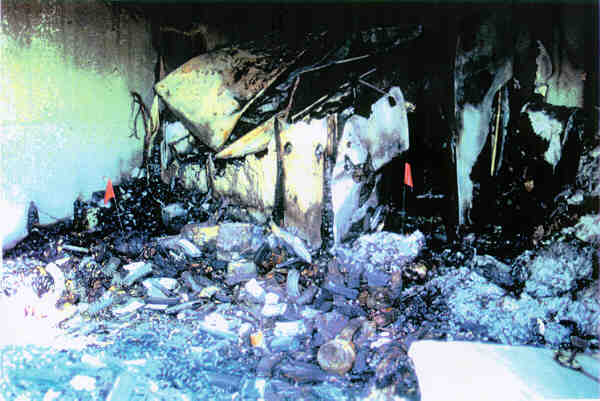NOT Crime Scene Photos
Directory of Exhibits
Catalogue of Evidence
Library
Search Museum Text
Print this page
|
|
20. NOT Crime Scene Photos Directory of Exhibits
|
|
|
These two photos were taken inside the concrete room. As crime scene photos they have little validity because they are not photographs of the crime scene; the interior of the concrete room underwent physical changes each day after the April 19 fire, occasioned by the damaged and crumbling concrete roof. Had standard techniques for the preservation of evidence been used, the roof would have been shored up immediately after the fire abated, and real crime scene photos might have been produced. (See Plausible Denial: The Texas Rangers.)

|
| Interior of Concrete Room Showing Refrigerator. A higher resolution version is linked to the image. |

|
| Interior of Concrete Room Showing Light Patterns. A higher resolution version is linked to the image. These unofficial images are not crime scene photos because the scene was obviously altered after the alleged crime and before the pictures were taken. |
The first, Interior of Concrete Room Showing Refrigerator, is a picture of the twisted wreckage of the walk-in refrigerator. Note the two red flags indicating the presence of bodies on the surface (buried bodies would not be visible to mark with flags). According to Dr. Peerwani, the surface bodies were removed early in the recovery process—April 22-23. The Autopsy Reports of those found on the surface show that the victims died variously of smoke inhalation, gunshot wound, stab wounds, or burns. (See Mt. Carmel Does 30, 31 A, 31 DE, 32, 33, 47, and 49). Their deaths were not due to falling debris from the "collapsed bunker."
On April 20, just after he arrived on the scene, Sgt. Coffman said the hole in the roof made by the explosion was small, about 18 inches to 24 inches in diameter. The steel-reinforced concrete that made up the roof was approximately six inches thick. Yet the rubble we see in the picture appears to contain sizable chunks of debris. Given the diameter of the hole (18-24 inches) and the depth of the concrete (six inches), the chunks of debris are too numerous and too large to have come from that hole. The large, chunky debris must have come from a source other than the roof.
The second picture shows another aspect of the concrete room. (Interior of Concrete Room Showing Light Patterns). In this photo, we see one red flag indicating a surface body (buried bodies would not be visible). Dr. Peerwani testified that the surface bodies were all removed early in the operation, April 22-23. Almost no daylight would have been available early in the recovery operation because then the hole in the roof was only 18 inches to 24 inches wide—quite small.
But there seems to have been plenty of light in the room when this picture was taken. Note light pattern on left wall and in the left foreground, and the round spot of light on the right. This spot on the right appears to be the same general shape as the hole in the roof. The light patterns on the left wall must be from other holes in the roof. This picture of the concrete room must have been taken toward the time the structure was demolished. At that time, of course, all of the surface bodies would long since have been removed. The guns may have been removed too, for Sgt. Coffman said it took just five days to clear the room.
The red flag then, is a prop. This photo, or another taken from a slightly different angle, has been published a number of times as evidence that the "bunker collapsed." The equation communicated by this photo is:
Bodies + collapsed roof = "They died when the bunker collapsed."
According to Sgt. Coffman's testimony, pieces of concrete gradually eroded from the roof when the evidence was being collected. The clusters of rods leaning against the wall are apparently guns, which had been placed by the Davidians on wooden gun racks along the back wall, according to Sgt. Coffman. These wooden racks had "little butt plates on the floor with the felt in them for each individual weapon to set on," "Transcript, pgs. 919, 920." It is perhaps surprising that wooden gun racks and the felt "butt plates" survived a fire which caused the severe damage to the refrigerator and incinerated the bodies.
In the arrangement Sgt. Coffman described, when the guns were in racks they would have been lined up next to each other in a straight line. Had the wooden racks burned, we might expect the guns to fall down helter-skelter, the barrels falling outward towards the center of the room. Instead they are standing up in clusters, and the barrels are facing the wall, as if someone had arranged them in this order after the fire.
Perhaps the guns are props, too, placed there to remind us that the Davidians owned guns.
Hey.
Next: Incineration
Back: Directory of Exhibits
Back: Death Gallery Entrance
Home: Museum Entrance
Search: Museum Text